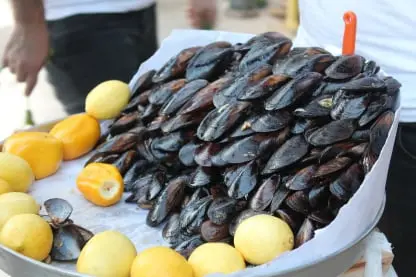Mussel quality inspection:
Mussel quality inspection app for safe mussels, consistent mussel quality inspection, mussel supplier quality control for importer/exporter and mussel producers.

Mussel Supplier quality inspection & management
The consideration of water quality in mussel farming is important. Mussels feed by filtering phytoplankton and in doing so they can accumulate and concentrate bacteria or viruses, some of which can be a risk to human health. These are often derived from land-based activities such as water treatment, storm drainage and diffuse agricultural run-off. Bio-toxins may also be contained in seasonally occurring marine algae and within Harmful Algal Blooms or HABs1, 2, which mussels can ingest.
For many reasons there is an on-going societal need to reduce coastal water pollution, and this is of particular importance to protect and enable the growth of bivalve aquaculture. Legislation exists to control water pollution, for instance that in the UK13, but pollution incidents do occur, and efforts continue to improve water quality14, 15.

Mussel Quality inspections during production
View App Specifications.
The consideration of water quality in mussel farming is important. Mussels feed by filtering phytoplankton and in doing so they can accumulate and concentrate bacteria or viruses, some of which can be a risk to human health. These are often derived from land-based activities such as water treatment, storm drainage and diffuse agricultural run-off. Bio-toxins may also be contained in seasonally occurring marine algae and within Harmful Algal Blooms or HABs1, 2, which mussels can ingest.
This study aims to understand the economic and bio-physical conditions under which mussel farming is a cost-effective mitigation measure to improve water quality related to excess nitrogen in fjords and coastal areas. We set-up a mixed-integer optimization model including every farm in three agricultural catchments surrounding Limfjorden, the largest fjord in Denmark. We include a number of relevant nitrogen abatement measures, including agricultural land-use measures and mussel farming in the sea. The aim is to model the least costly combination of mitigation measures to improve water quality when agricultural, environmental and market conditions vary. We run three scenarios varying environmental conditions for mussel productivity and market opportunities for mussel-based products as organic animal feed. We analyze the resulting marginal abatement costs and draw insights about the potential scale of mussel farming for the different catchments. We show that mussel farming is a cost-effective option for 2 of the 3 catchments, but that decreasing mussel productivity over time may make the measure ineffective for one of the catchments, if a market for feed is not available. The possibility of a market for mussel-based organic feed significantly increases the share of nitrogen reduction done by mussels and decreases overall costs by up to 65%. Ultimately, the results indicate that, for catchments where environmental conditions are adequate, mussel farming can be a cost-effective nutrient reduction measure. Therefore, mussel farming can potentially increase the cost-effectiveness of incentive schemes aimed at reducing eutrophication in fjords and coastal waters.

Mussel Quality control & management
European Hygiene Regulations6 state that shellfish business operators are responsible in ensuring that bivalve molluscs meet strict standards. The UK Food Standards Agency, in compliance with European regulations, has classified shellfish harvesting areas and beds on the basis of the level of the bacterium E.coli in mollusc flesh. Depending on shellfish production area classification (A, B or C) certain procedures must be followed to enable harvested mussels to enter the market. Molluscs harvested from Class A areas can go straight to market, but they are often purified (depurated) to provide additional assurance of quality; those harvested from Class B areas must be purified before being sold to consumers. All molluscs sold on the UK market must contain less than 230 cfu (colony forming units) of E.coli per 100 g of flesh7, 8.

Daily Mussel factory hygiene checklist
Depuration is a technique whereby live shellfish and bivalves, that may contain undesirable substances (e.g. sand, silt), pollutants, parasites or organisms of possible harm to human beings (e.g. pathogenic bacteria), are placed in systems with continually circulated and sterilised seawater for a specific period of time in order to clean themselves9. Depuration is effective in removing many undesirables, but it is not in regards to removing viral contamination (e.g. norovirus)10. However, mussels are not eaten raw (unlike some other shellfish such as oysters) and appropriate cooking can eliminate the norovirus risk. End product testing of live shellfish is also undertaken in countries such as the UK, to ensure shellfish products that enter the market are safe to eat11, 12.